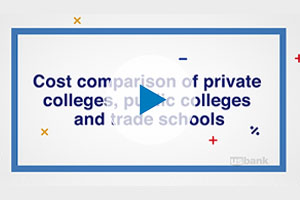Apply for the most favorable student financial aid options first, so you can graduate with the least amount of debt possible.
College can be expensive, so many students include financial aid as part of their college savings plan. Study your options first, and then take a systematic approach when you apply. Here’s what you need to know to guide your financial aid decisions.
Grants and scholarships: Go for the free money first
Grants and scholarships should be at the top of your list for funding a college education for one simple reason: You don’t have to pay them back. To find out if any of these options might be available to you, start with the financial aid office at your school.
While the terms are often used interchangeably, they are different. A grant is usually need-based, while a scholarship is usually merit-based.
Federal student loans: Your next-best bet
If grants and scholarships come up short, federal student loans should be the next option on your checklist. These government loans give you flexible repayment and deferment options, and they typically have lower interest rates than private loans from banks and other lenders.
Even though you may not have to start repaying student loans (federal or otherwise) until after you graduate, for most loans the interest clock starts ticking as soon as the loan is issued. So, borrow only the amount you need as a way to limit your debt after graduation.
For example, if you are an incoming freshman and take out a $20,000 student loan at an interest rate of 5 percent, by the time you settle into your sophomore year, the amount you owe on that freshman-year loan will have quietly grown to $21,000. If you’re at a four-year school, it will grow to more than $24,300 by the time you graduate.
Want to apply for Federal student loans? Follow these steps:
- Fill out the FAFSA form: Even if you haven’t committed to a school yet, you should download a Free Application for Federal Student Aid (FAFSA), which determines how much you and your family must contribute each year for your education. (Already know your school? Then be sure to check in with the financial aid office before completing the FAFSA — some schools want students to use the school’s own application form when applying for federal loans.)
- Fill out the CSS Profile: Many colleges and scholarships that offer nonfederal financial aid require a CSS Profile™, so it’s important to fill out this form as well.
- Send in your forms - ASAP! Complete the FAFSA and CSS Profile and submit them as soon as possible. Many awards are given on a first-come, first-served basis, so there is an advantage in submitting early.
- Review your financial aid award letter: Each college will send a financial aid award letter outlining the awards being offered, which can include grants, loans and even work-study options. Carefully compare all the financial aid offers you receive as a way to help you choose a college that is the right fit academically and financially.
Your award letter, and your FAFSA Student Aid Report, will also list how much your family is expected to contribute toward your education. This doesn’t necessarily mean your family actually has the money on hand. If your family needs additional funding to meet its expected contribution, a private student loan from a bank or other lender can help.
Private student loans: It pays to shop around
Private student loans are offered by banks, schools and education loan organizations. You should turn to them only when federal loans, grants, scholarships and other sources of income come up short.
Interest for private student loans varies by lender. Many lenders also charge fees to review and process your loan application. When comparing lenders, be sure to ask whether they charge any “origination fees” or other fees in addition to interest, what your final amount due will be and when you’ll have to repay it.
Paying back your student loans: Set yourself up for success
Remember, both federal and private student loans must be repaid even if you don’t finish school or aren’t happy with the education you receive. Get ahead of your repayment plan by creating a budget and sticking to it. One tip is to set up a separate savings account for your loan repayment and automatically transfer money into it each pay period.
Bottom line: A college education might be the most important investment you’ll ever make — the one that unlocks your future earning potential — but student loans should be used wisely. Only borrow as much as you need, and don’t overleverage yourself.
Continue reading to learn more about paying for education.












